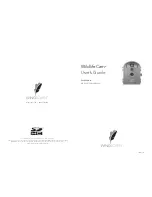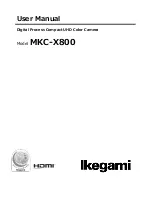
Set the flash frequency and
3
flash times.
Press <
> button to select the
item (blinks).
Turn the Select Dial to set the
number and press < > button
again to confirm. The next item to
be set will blink.
After you finish the setting, press
<
> button and all the settings
will be displayed.
●
●
●
Multi: Stroboscopic Flash
With stroboscopic flash, a rapid series of flashes is fired. It can be
used to capture a multiple images of a moving subject in a single
photograph.
You can set the firing frequency (number of flashes per sec.
expressed as Hz), the number of flashes, and the flash output.
Press < > button so that
1
<
MULTI
> is displayed.
Turn the Select Dial to choose
2
a desired flash output.
Calculating the Shutter Speed
During stroboscopic flash, the shutter remains open until the firing
stops. Use the formula below to calculate the shutter speed and set
it with the camera.
For example, if the number of flashes is 10 and the firing frequency is
5 Hz, the shutter speed should be at least 2 seconds.
Number of Flashes / Flash Frequency = Shutter Speed
To avoid overheating and deteriorating the flash head, do not
use stroboscopic flash more than 10 times in succession.
After 10 times, allow the camera flash to rest for at least 15
minutes. If you try to use the stroboscopic flash more than 10
times in succession, the firing might stop automatically to
protect the flash head. If this happens, allow at least 15
minutes’ rest for the camera flash.
1/4
1/8
1/16
1/32
1/64
1/128
10
2
4
8
20
50
70
11
2
4
8
20
40
70
12-14
2
4
8
20
40
60
15-19
2
4
8
18
35
50
20-50
2
4
8
16
30
40
60-199
2
4
8
12
20
40
Hz
If the number of flashes is displayed as “--”, the maximum number of
flashes will be as shown in the following table regardless of the flash
frequency.
Flash Output
Number of Flashes
1/4
2
1/8
4
1/16
8
1/32
12
1/64
20
1/128
40
Wireless Flash
This product supports wireless flash application and functions
as either a master or a slave unit. As a master unit, it can control
Canon speedlites e.g. 580EXII, 600EX-RT via wireless. As a slave
unit, it can receive wireless signals of Canon speedlites e.g.
580EXII, 600EX-RT and commanders of Canon cameras e.g.
7D/60D/600D.
- 13 -
- 14 -
Figures displayed when reducing flash output level
→
←
Figures displayed when increasing flash output level
1/4
1/2
1/1
1/1–0.3
1/2+0.7
1/1-0.7
1/2+0.3
1/2-0.3
1/4+0.7
1/2-0.7
1/4+0.3
······
······
Flash Output Range
The following table makes it easier to see how the stop changes in
terms of f/stop when you increase or decrease the flash output. For
example, when you decrease the flash output to 1/2, 1/2-0.3, or 1/2-
0.7, and then increase the flash output to more than 1/2, 1/2+0.3,
1/2+0.7, and 1/1 will be displayed.
●
●
●
●
●
Stroboscopic flash is most effective with a highly reflective
subject against a dark background.
Using a tripod and a remote control is recommended.
A flash output of 1/1 and 1/2 cannot be set for stroboscopic
flash.
Stroboscopic flash can be used with“
buLb
”.
If the number of flashes is displayed as “--”, the firing will
continue until the shutter closes or the battery is
exhausted. The number of flashes will be limited as shown
by the following table.
Maximum Stroboscopic Flashes:
1/4
1/8
1/16
1/32
1/64
1/128
1
7
14
30
60
90
100
2
6
14
30
60
90
100
3
5
12
30
60
90
100
4
4
10
20
50
80
100
5
4
8
20
50
80
100
6-7
3
6
20
40
70
90
8-9
3
5
10
30
60
80
Flash
output
Hz
Flash
output
●
You can set up two to three slave groups for E-TTL II autoflash
shooting. With E-TTL II autoflash, you can easily create various
lighting effects.
































